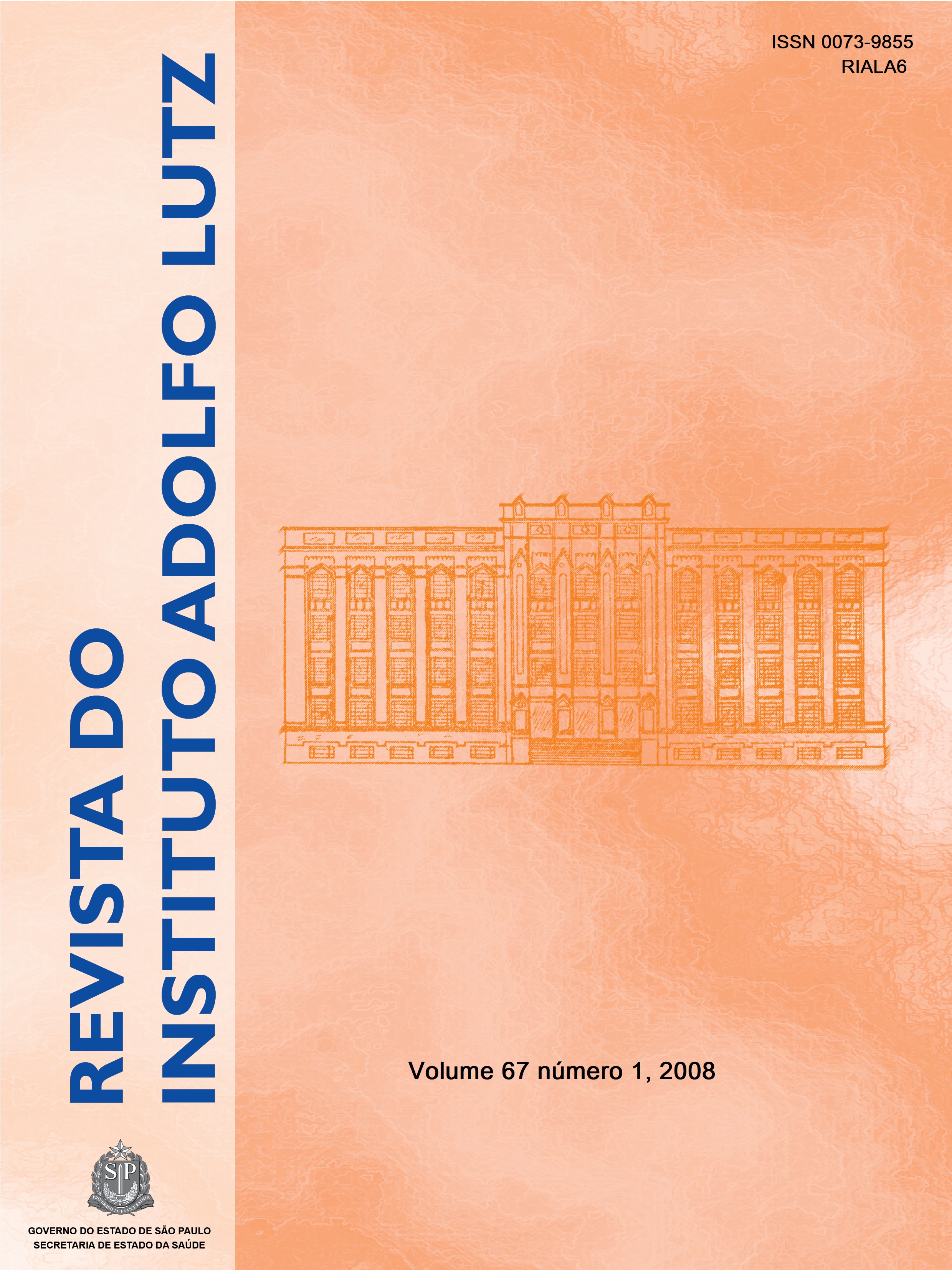Resumo
O parvovirus humano B19 foi isolado e caracterizado de amostra clínica de um paciente, infectado no Japão, e que apresentou os sintomas de febre e erupção cutânea após sua chegada ao Brasil. A infecção por parvovírus foi confirmada por meio de seguintes ensaios: Elisa para detecção de anticorpos IgM antiparvovirus B19 e técnica de polymerase chain reaction (PCR). Um fragmento da região NS1-VP1 foi diretamente submetido ao seqüenciamento do nucleotídeo. A análise filogenética parcial do B19, frente às várias seqüências disponíveis no GenBank, indicou que PV B19 isolado correspondeu ao genótipo 1.
Referências
1. Siegl GR, Bates RC, Bern KI, Carter BJ, Kelly DC, Kurtak E, etal. Characteristics and taxonomy of Parvoviridae. Intervirology. 2005;23:61-71.
2. Chen YS, Chou PH, Li SN, Tsai WC, Lin KH, Tsai KB, Yen JH,Liu HW. Parvovirus B19 infection in patients with rheumatoidarthritis in Taiwan. Rheumatol. 2006 ;33:887-91.
3. Corcoran A, Doyle S. Advances in the biology, diagnosisand host-pathogen interacrions of parvovirus B19. JMedMicrobiol. 2004;53: 469-75.
4. Hemauer A., Poblotzki AV, Gigler A, Cassinotti P, Siegl G, WolfH, et al. Sequence variability among different parvovirus B19 isolates. J Gen Virol. 1996;77:1781-5.
5. Parsyan A, Szmaragd C, Allain JP, Candotti D. Identificationand genetic diversity of two human parvovirus B19 genotype3 subtypes. JGen Virol. 2007;88:428-31.
6. Servant A, Laperche S, Lallemand F, Marinho V, De SaintMaur G, Meritet JF, et al. Genetic diversity within humanerythroviruses: identification of three genotypes. J Virol.2002;76:9124-34.
7. Ekman A, Hokynar K, Kakkola L, Kantola K, Hedman L,Bondén H, Gessner M, Aberham C, Norja P, Miettinen S,Hedman K, SA¶derlund-Venermo M. Biological andimmunological relations among human parvovirus B19 genotypes 1 to 3. J Virol. 2007;81:6927-35.
8. Baylis SA, Fryer JF, Grabarczyk P. Effects of probe bindingmutations in an assay designed to detect parvovirus B19: implications for the quantitation of different virus genotypes. J Virol Methods. 2007;139:97-9.
9. Durigon EL, Erdman DD, Gary GW, Pallansch MA, Torok TT,Anderson LJ. Multiple primer pairs for polimerase chainreaction (PCR) amplification of human parvovirus B19 DNA.J Virol Methods. 1993;44:155-65.
10. Altschul S, Madden T, Schaffer A, Zhang OZ, Miller W, LipmanD.G. Blast and PSI-Blast. A new generation of protein tatabascscarch programs. Nucleic Acids Res. 1997; 25:3389-402.
11. Yaegashi N, Shiraishi H, Takeshita T, Nakamura M, Yajima A,Sugamura K. Propagation of human parvovirus B19 in primaryculture of erythroid lineage cells derived from fetal liverculture. J Gen Virol. 1989;63:2422-6.
12. Swofford DL. PAUP*. Phylogenetic Analysis Using Parsimony (*and Other Methods). In: Sinauer Associates 4thed. Sunderland: Massachusetts; 2003.
13. Posada D, Crandall KA. ModelTest: testing the model ofDNA substitution. Bioinformatic. 1998;14: 817-8.
14. Broliden K, Tolfvenstam T, Norbeck O. Clinical aspects of parvovirus B19 infection.J Intern Med. 2006;260:285-304.
15. Saldanha J, Lelie N, Yu MW, Heath A. B19 Collaborative Study Group. Establishment of the first World Health Organization International Standard for human parvovirus B19 DNA nucleic acid amplification techniques.Vox Sang.2002;82:24-31.
16. Cohen BJ, Gandhi J, Clewley JP. Genetic variants ofparvovirus B19 identified in the United Kingdom: implicationsfor diagnostic testing. J Clin Virol. 2006;36:152-5.
17. Us T, Ozune L, Kasifoglu N, Akgun Y. The investigation ofparvovirus B19 infection in patients with haematological disorders by using PCR and ELISA techniques. Braz J InfectDis. 2007;11:327-30.
18. Heegaard ED, Jensen IP, Christensen J. Novel PCR assay fordifferential detection and screening of erythrovirus B19 anderythrovirus V9. J Med. Virol. 2001;65:362-7.
19. Umene K, Nunoue T. The genome type of human parvovirusB19 strains isolated in Japan during 1981 differs from typesdetected in 1986 to 1987: a correlation between genome typeand prevalence. J Gen Virol. 1990;71:983-6.
20. Sanabani S, Neto WK, Pereira J, Sabino EC. Sequencevariability of human erythroviruses present in bone marrowof Brazilian patients with various parvovirus B19-relatedhematological symptoms. Clin Microbiol. 2006;44:604-6.

Este trabalho está licenciado sob uma licença Creative Commons Attribution 4.0 International License.
Copyright (c) 2008 Maria Isabel de Oliveira, Ana Maria Sardinha Afonso, Cristina Adelaide Figueiredo, Ana Lucia Frugis Yu, Suely Pires Curti
